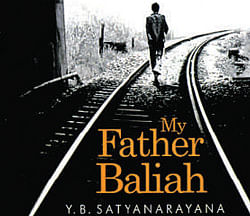
My father Baliah
Y B Satyanarayana
Harper Collins
2011, pp 211
299
Unnava Lakshminarayana (1877-1958) wrote a Telugu novel while in jail, focussing on the plight of the Dalits.
Till today, Malapalli remains an icon for people taking up social reform. A rare social document, the novel speaks of the conflict between landowners and labour, of the rooted presence of untouchability in Indian villages, and of course, the Christian preachers trying to fish in troubled waters.
Compared to the epoch-making classic that can still raise a storm in our hearts, My Father Baliah is a soft-spoken reminiscence of the emergence of Dalit power. Here we have a continuous run of a success story, though it opens with the terrible scene when Narsiah buries his dear wife all by himself without any help. He will not stay in this heartless village anymore! His little boy Ramaswamy is the hero Baliah of Dr Satyanarayana’s memoir.
In Malapalli, we have the Mala caste where the family of Ramadas has already been ‘sanskritised’ somewhat due to the influence of Ramanuja Siddhanta. Ramadas realises that it is the occupation of the Malas, which deals with dead cattle and drying skins, that has kept them away from the main village. Why, even Muslims look down upon them!
Baliah’s grandfather was a cobbler and this again is dealing with animal skin. Once, he made a nice pair of shoes and presented it to the Nizam who was passing by the village. He received a vast tract of land as a gift because the Nizam was pleased. But which Dora (landlord) can allow a Madiga to possess land as his equal in the village? Unthinkable! The rest is sad history.
But it was perhaps for the good of the family. Moving out of the village gave Narsiah a chance to work as a pointsman in the Railways. Thanks to the author, we get to know quite a bit about the growth of the Railways in India. When the Great Indian Peninsula Railway Company was formed in the early years of the last century, a new era began for the British and the natives.
“Much manual labour was required to lay the railway tracks through the length and breadth of the country, through thick forests and high mountains, and over surging rivers. To such hazardous jobs the untouchables had wide access since, barring a few Sudras, no other ‘touchable’ was ready to undertake them. People from the untouchable communities were recruited in large numbers all over the country, though even here they constituted the lowest rung. These workers were called gangmen.”
Regular income and railway quarters brought education in their wake. While other men drank a lot and even sold the groceries at home to get pots of liquor, Baliah just draws from the brink. He grows up into a hardworking railwayman and marries Narasamma.
They are happy though Baliah manages to marry Laxmamma in the cheera raika tradition, and has a boy Anjiah. Fortunately for him, Narasamma is blessed with patience and maternal love (she has 11 children) and brings up Anjiah also as her own, when Laxmamma leaves the family and goes away. Baliah’s children (except three who die in infancy) come up very well, thanks to his insistence upon educating them. Dr Satyanarayana himself is a retired professor of chemistry and so are three of his brothers.
There is a steady upward rise in the family’s social life. Education brings its own problems for what has been a close-knit family. The author marries a politician’s daughter; another marries a Brahmin. Financial insecurity is a permanent shadow for Baliah. It is amazing how Narasamma, along with Baliah, elicits the friendliness of her daughters-in-law though the sons live separately now. The family which had known only Durgamma’s cradle and Narasimha as gods and had performed no rituals undergoes a relentless transformation.
“But now I would find pictures of gods and goddesses like Saraswati, Lakshmi, Ganapati and Venkateswara in our families. In some of my brothers’ houses, a holy tulsi plant was also placed according to the rules of vaastu. In fact, Narsing Rao and Anjiah engaged in daily worship with the ritualistic ringing of a bell.”
Then why did Dr Satyanarayana convert to Buddhism in 2006? Perhaps the clue is to be found in the college he worked for, as principal. He says that it was not the Brahmins who were the problem as they were “friendly, reliable and helpful” but a Reddy lecturer who resented working under a Madiga.
However, even this conversion may not help. There is still a long way to go. Dr Ambedkar’s firm message (quoted in the expressive foreword by S R Sankaran) says it all: “struggle and more struggle, sacrifice and more sacrifice.” The cover picture brings hope and proves that My Father Baliah is perhaps the light seen at the end of the tunnel.